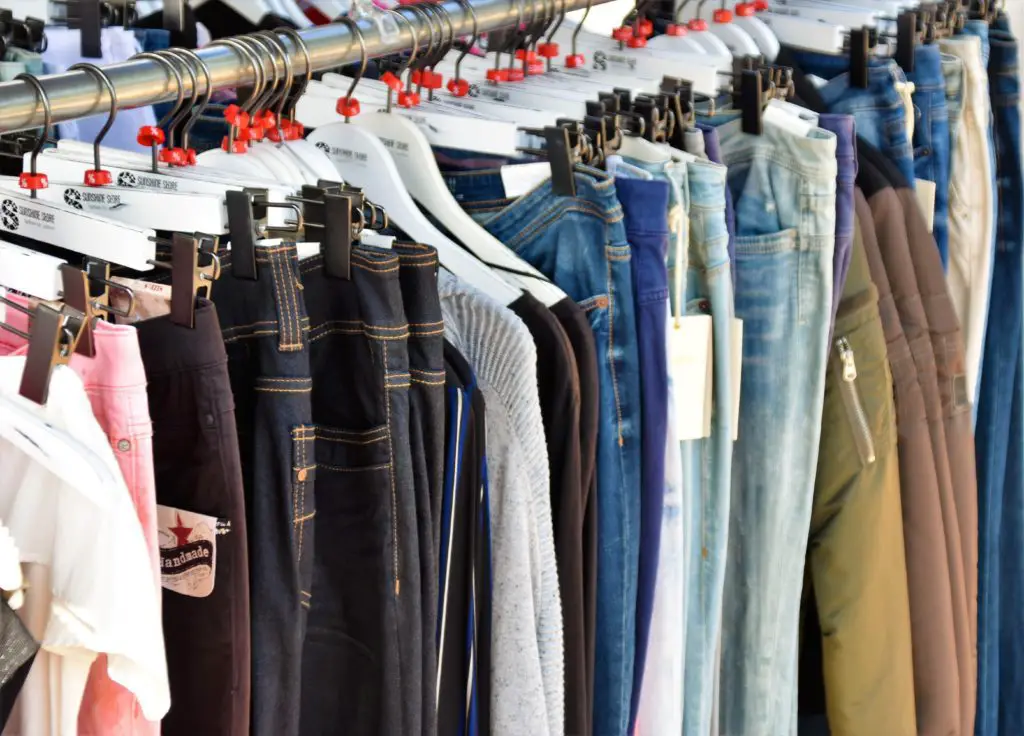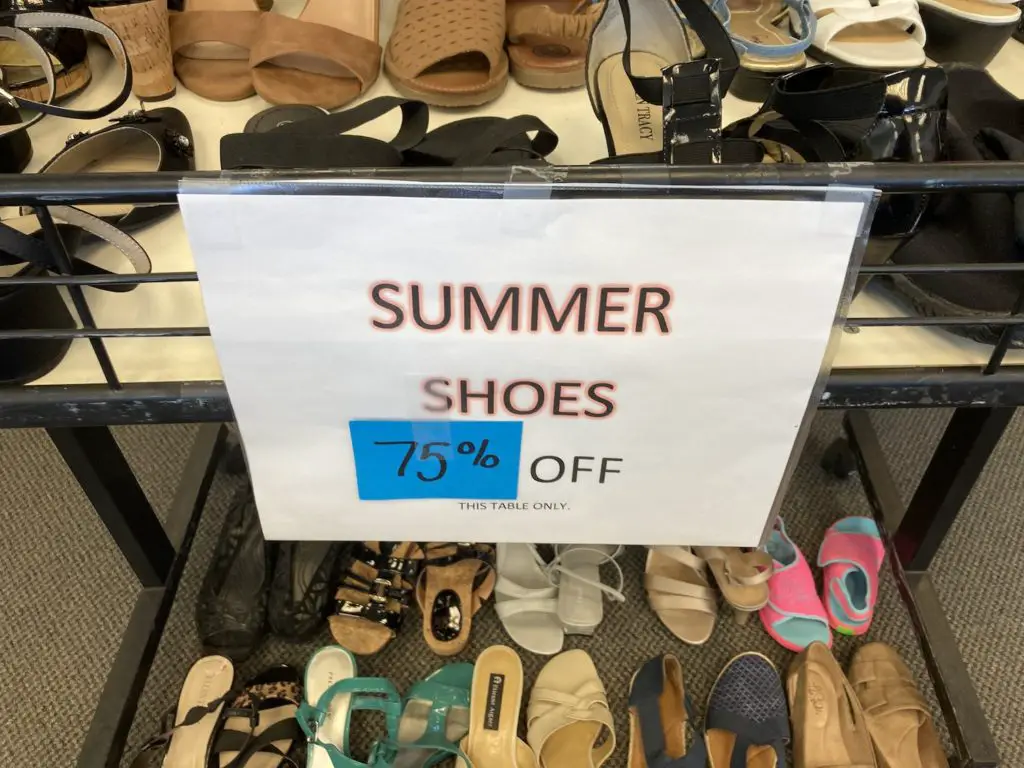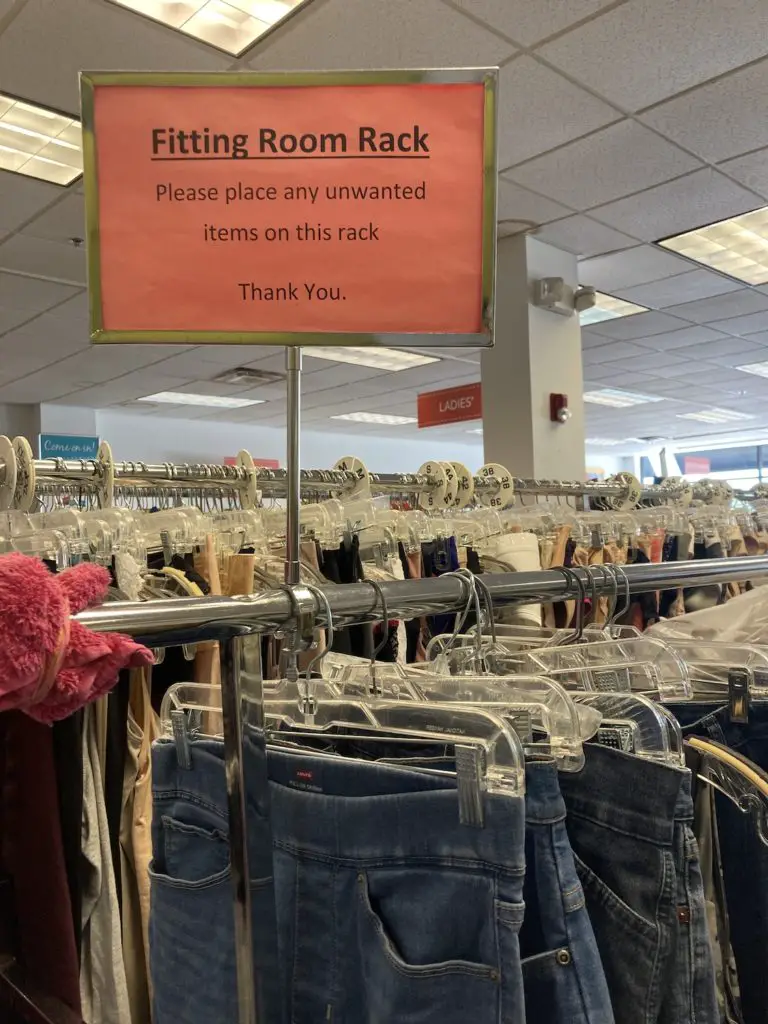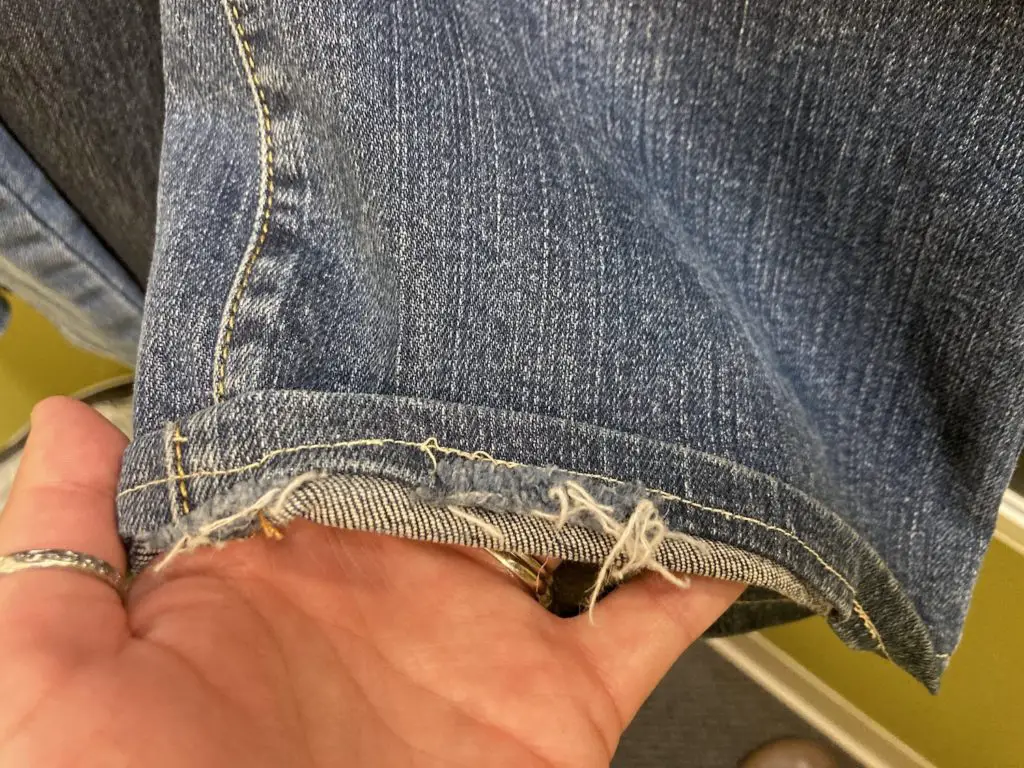Thrifting has become a huge, trendy scene, but people have been thrifting long before places like Poshmark existed. Some of us have been shopping at thrift stores with our parents since we were kids, shopped there all through our teens and 20s, and now shop there to keep our own kids dressed to the 9s. I even got my prom dress from a thrift store! I’ve got this process down to a science.
Thrifting can be a great alternative if you’re struggling to stop buying stuff, since it’s way cheaper and the hunt for good finds can be more exciting.
Many people shop at thrift stores while they’re trying to save money on baby stuff. If you’re primarily looking to thrift for children’s clothes though, I’ve also got a guide to scoring free baby clothes that might be useful.
So without further ado, let’s get right down to the thrifting tips you need to know today before your next thrift shopping trip.

Thrifting Tips- Before You Leave the House
1. Plan Shopping Days Around the Discounts
Many stores run promotions to get shoppers in the door. Some of these include senior, veteran, or student days, reduced price gift card sales, ‘double point days,’ “$2 Tuesdays,” and more. Knowing your store’s special days helps you know when to shop. The easiest way to learn all this is to ask a cashier or stocker to explain their system to you.
However, you can do a little research online. This is the Goodwill store locator. Once you’ve found your location, check the ‘store’ tab for their calendar of discounts, sales, and other promotions. Savers also has a “super saver club” and text alerts for awesome deals.
2. Set a budget
Thrift shopping can be a dangerous sport. “It’s all so cheap!” you think gleefully to yourself as you fling items in your cart. “I can’t pass it all up!” And then you come home with five pairs of shoes that only slightly fit and two winter coats when you live in Miami.
Instead, set yourself a budget. The dollar amount should be enough to cover whatever you’ve put on your list, plus a few dollars more in case you see something that’s an incredible steal.
3. Prepare a List
The easiest way to save money while thrifting is to not buy crap you don’t need. You don’t go grocery shopping without a list right? (Right?) So why would you go thrifting without a list? That’s a recipe for disaster.
I find it’s helpful to keep a running list of clothing and household needs on my phone. I call it my “to hunt for” list. That way, I can add to it whenever I realize a need and whip the list out whenever I’m thrifting.
The list is also a helpful place to add items that would make your life better, but are non-essential or immediate needs that might possibly warrant paying full price.
My current list includes several items that have been on the list for YEARS, but I just haven’t found the right item or deal yet. Once, it took me four years to find a fireplace electric heater (with a mantel, for Christmastime), but I snagged one for $5 at a yard sale when they retail for $80. That’s the power of a “hunting” list!
4. Know When Restock Day Is
Each store will be different, but I’ve found employees are more than happy to explain things to you. Generally, stores will have one or multiple days when they stock the shelves with fresh merchandise (some even stock EVERY day). These days won’t change from week to week, so you can start to get a rhythm down once you know.
Going shopping on restock day (and even better, at opening) will give you first pick of all the new items.

5. Learn the Sale Cycles
Anyone who’s shopped there knows Goodwill stores have colored tags. Every week, a new color of tag goes on sale for 50% off (or sometimes more!). These are the clothes that have sat on shelves and hangers longest and need to get sold before they’re removed.
Each store sets their own sales cycle, so you’ll need to ask an employee about this, too.
6. Plan Your Route
Most people focus on retail thrift stores like Salvation Army, Goodwill, and Savers since they sell actually usable items. However, you don’t have to limit yourself to these! Places like churches often have thrift stores, plus there are pop up estate sales, garage sales, and moving sales. These last kind especially can be good for finding killer deals, though you’ll likely have to sift through much more junk to get the treasures.
7. Get Measurements & Bring a Tape Measure
Whether you’re buying furniture or clothes, you need to know proper sizes before you take something home. There’s no return policy at many thrift stores, so mistakes can be costly.
If you’re shopping for your own clothes, you don’t necessarily need to bring your own measurements. That said, it is a handy thing to know in case the store doesn’t have available dressing rooms. I know many thrifters swear by wearing a ‘catsuit’ of skintight shorts and a tank top, which does solve this problem since you can try on things in the aisles. That’s not something I’m personally comfortable with however.
If you’re shopping for other family members, get some of their current body size measurements. Waist, inseam, collar, and arm length are the basic ones, but possibly also head and shoe size depending on what you’re buying. Make sure to write them all down in a special thrifting notebook or a specific note app on your phone.
If you’re shopping for growing kids, it makes more sense to bring an item of clothing they currently fit into for comparison.
Why go through all that trouble? Clothes sizes aren’t always accurate when you’re buying used. Clothes shrink, shift, and stretch with wear, and unless an item still has its original tags, there’s a good chance the sizes won’t match what you’re used to in a department store.
8. Visit Often
Because the inventory of thrift stores changes so much, you really need to visit often in order to catch the good stuff when it comes in.
For an average store, going for 15-30 minutes 2-4 times a month is ideal. They don’t typically have so much turnover that you’ll see a completely different set of merchandise each week, so you can learn to visually filter out the stuff you’ve seen a few times.
One great way to get this in is to find thrift stores on the routes you already use to do errands, commute to work, or drop kids off at school.
Thrifting Tips- While You’re Shopping

9. Check the “Money Racks”
And by “money racks,” I mean the ones next to the dressing rooms. This is where people dump the clothes that were worth trying on, but didn’t fit them. The money racks are where you can find good quality, trendy, or high-end clothes that other shoppers might miss since they’re not in their “correct” sections.
10. Know What Quality Looks Like
Generally, clothes from ‘fast fashion’ brands are made cheaply and designed to wear out quickly, meaning you’ll need to keep buying more and more.
Quality clothes, on the other hand, will last you a long time, despite many uses. You can tell if something’s quality by a few markers:
- Natural materials like wool, 100% cotton, linen, silk, cashmere, and genuine leather
- Tighter stitches: poor-quality clothes are made so fast the distance between stitches can be long and loose
- Sturdy accessories: clothes with zippers, buttons, and fasteners made of metal or wood are likely to be higher quality than those made of plastic
- Jackets with lining
- Labeled with a fabric tag instead of a plastic or printed one
11. Check The Label
Labels are an excellent source of information when it comes to spotting a good piece. Once you learn the names of a few brands that produce high-quality clothes, they stand out a mile away.
If you don’t know if something is a good deal or not because you’re unfamiliar with the brand, you can look it up in the Vintage Fashion Guild. They have multiple guides with pictures of various labels going back to the 1800s, ways to identify different kinds of fabric, and more.
12. Don’t Limit Yourself to One Section
Like I mentioned earlier, used clothes aren’t the same size now as they were originally. And even if they were, sizes vary so much from one brand to the next that they’re almost meaningless in a thrift store or yard sale.
Plus, because so many clothes from so many brands get donated to thrift stores, the employees can’t catch everything. You can often find men’s clothes in the women’s section, or a XS adult shelved with the big kid’s clothes.
So check a variety of sections! I’d suggest checking a few sizes below and above your usual pant/skirt/dress size, and at least glance through the size below and above your shirt size.
13. Shop in the off-season
Because thrift stores don’t usually have giant warehouses where they can store products, they need to sell everything they have before they can bring in new stuff. (Otherwise, much of it gets shipped overseas and turned into industrial rags, or even home insulation.)
So if a new season is approaching, you can get insane savings. You can’t wear that winter coat or summer bikini for six more months, but you can stash it in your closet for an insanely low price in the meantime.
14. Bring a Donation
Many stores like Goodwill and Savers have deals where you can get a 20% off coupon just by making a donation of household items or clothing. Just make sure you’re not donating trash, as thrift stores have a massive problem with this.
Even if you won’t get a coupon for making a donation, consider making one anyways. Thrift stores can’t function without a steady flow of good donations, and by both shopping and donating, you’re keeping them in business!
15. Visually Scan
Because anywhere that sells used items can be overwhelming, you need to be a good scanner. Trying to carefully look at each piece individually will frustrate you into giving up.
Instead, I suggest flipping through clothes racks while keeping your eye on the middle of the hanger. This is where you can see all the most important information: brand labels and sizes. It’s also easy enough to see the main color of the piece from this eye level too, if you’re looking for something in particular.
16. Watch Out for Damaged Goods

Thrift store employees can’t catch everything. And even if they could, they might still put items out on the floor if it’s not too badly damaged. (Anything they can’t sell they have to pay to throw away.)
If you really need something and have the skills to repair it, you can take a chance. You might even be able to negotiate with the cashier or their manager for a discount, if you really wanted to try haggling over damaged clothes in the thrift store.
Armpits, necklines, wrists, and clothes at belly-button height are likely places for stains. The bottom hems and crotches of pants, toes of shoes, and belt loops are where you’ll see the most wear and tear, and possibly rips.
Thrifting Tips- Back At Home
17. Wash Your Clothes
For the longest time, I thought all clothes in a thrift store were laundered in the back somewhere. Nope! The nice people working at your neighborhood Goodwill don’t have time for that. So here’s one of the most important thrifting tips: give everything a good soak, put through the wash, and if you can, line-dry it on a clothes line. This way, you’ll get everything smelling good and anything icky gets washed away.
18. Care for Your Finds
If you sunk time, effort, and money into bringing these clothes into your home, spend at least a fraction of that into maintaining your clothes. Learn how to tell when clothes are getting worn, and reinforce them if you can. Learn to patch holes, sew buttons, and fix busted zippers. Youtube is chock full of how-to tutorials if you need a guide!
Hope you learned from these thrifting tips today! If you’d like to see more frugal tips and tricks, consider subscribing to my newsletter below for bi-weekly emails.
